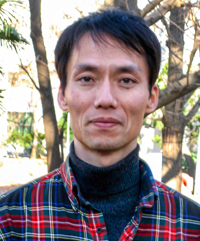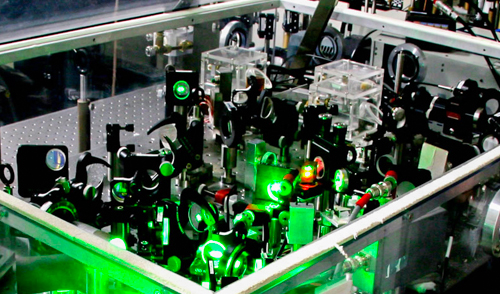June 2014 Issue
Feature
Frontiers of optical science: Ultrashort pulses of light produced by Raman scattering from hydrogen for next generation laser optical communications

Masayuki Katsuragawa
Recent advances in the performance of powerful lasers, optical fibers, and peripheral technology have played a pivotal role in the proliferation of global telecommunications based on the transmission of 10 GHz pulses of light. Notably, the three most important properties of lasers for telecommunications are high power, single frequency, and ultra-short pulse width. But what innovations lie ahead? The answer to this question can be found in the research being conducted by Professor Masayuki Katsuragawa, at the Department of Applied Physics and Chemistry, UEC.
"My research is focused on the manipulation of light-matter interaction for producing ultra-short pulses of laser light," says Katsuragawa. "Our recent experiments on adiabatic stimulated Raman scattering in parahydrogen show potential for the realization of laser light sources producing pulses at terahertz repetition-rate frequencies. These ultra-short pulses offer a new 'axis' in the evolution of laser based optical science."

Here, the new 'axis' refers to ultrahigh-repetition-rate trains of monocycle pulses with precise control of the phase of the laser light pulses. Recently, Katsuragawa and his colleagues have reported on the realization of ultrashort pulse trains of 1.8 femto seconds (fs) in duration and repetition frequency of 125 terahertz (THz) by stimulated Raman scattering (SRSs) produced in parahydrogen. "The critical point in these experiments was driving Raman coherence adiabatically, that is, without dissipation," explains Katsuragawa. "We achieved this by developing an injection-locked laser capable of emitting arbitrary pairs of two friequencies to irradiate the hydrogen gas, in order to control two photon detuning from the Raman resonance."
Recently, the UEC team has produced higher order series of stimulated Raman scattering using two driving lasers by the introduction of a second harmonic in one of the lasers. The resulting emission referred to as a 'Raman comb', covered an octave spectrum range from the infrared to the ultraviolet.
"I am confident that our research has laid the foundations for the development of practical systems for the generation of trains of monocycle pulses with total control of the phase," says Katsuragawa.
Further information
- Masayuki Katsuragawa website:
- http://www.mklab.es.uec.ac.jp/index_e.html
References
- M. Katsuragawa and T. Onose, Dual-Wavelength Injection-Locked Pulsed Laser. Optics Letters 30, 2421-2423 (2005).
- M. Katsuragawa, K. Yokoyama, T. Onose, and K. Misawa, Generation of a 10.6-THz ultrahigh-repetition-rate train by synthesizing phase-coherent Raman-sidebands, Optics Express 13, 5628-5634 (2005).
- T. Suzuki, M. Hirai, and M. Katsuragawa, Octave-spanning Raman comb with carrier envelope offset control. Phys. Rev. Lett. 101, 243602-243605 (2008). Cover
- M. Katsuragawa, T. Suzuki, K. Shiraga, M. Arakawa, T. Onose, K. Yokoyama, F. L. Hong, and K. Misawa: Ultrahigh-repetition-rate pulse train with absolute-phase control produced by an adiabatic Raman process, Laser Spectroscopy, Proceedings of the XIX International Conference, ICOLS 2009, ISBN-13 978-981-4282-33-8, World Scientific (2010).
- K. R. Pandiri and M. Katsuragawa, A 10 THz Function Generator - generation of rectangular- and triangular- shaped pulse trains -, New Journal of Physics 13, 023030 (2011).
- Muneaki Hase, Masayuki Katsuragawa, Anca Monia Constantinescu & Hrvoje Petek, Nature Photonics 6, 243-247, (2012).
- 7. K. Yoshii, J. K. Anthony, and M. Katsuragawa, The simplest rout to generating a train of attosecond pulses. Light: Science & Applications 2, e58 (2013); DOI:10.1038/lsa.2013.14.



